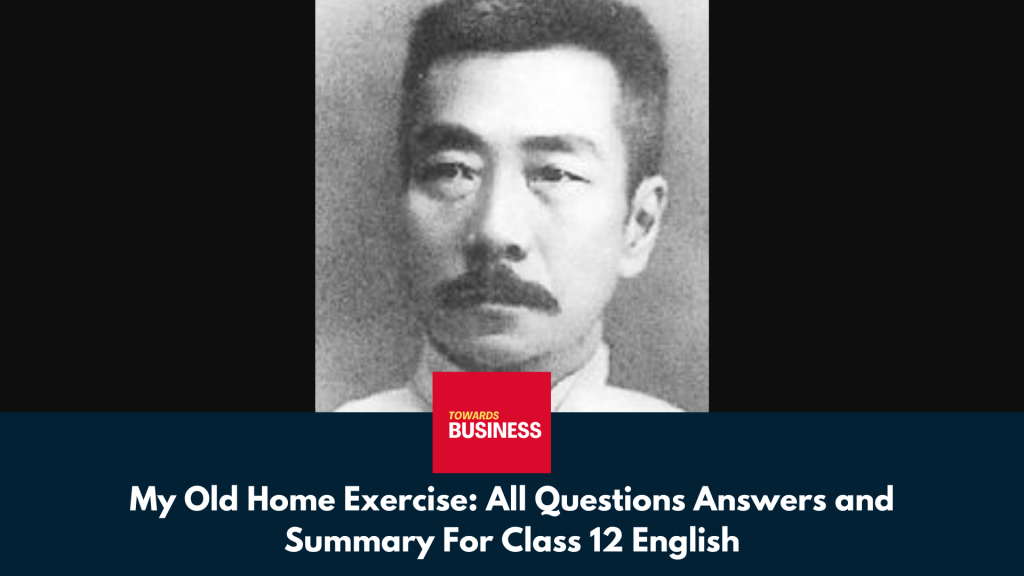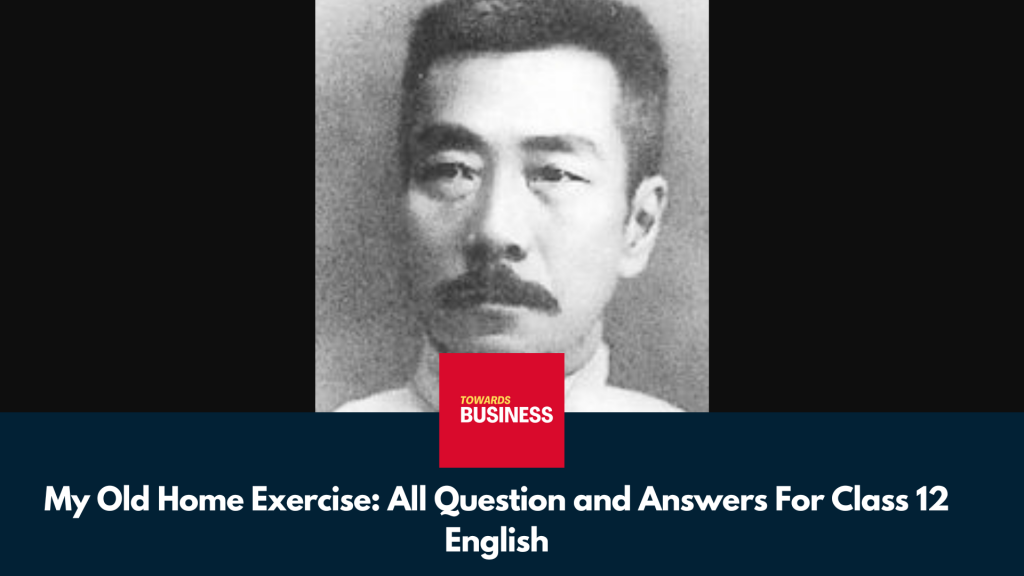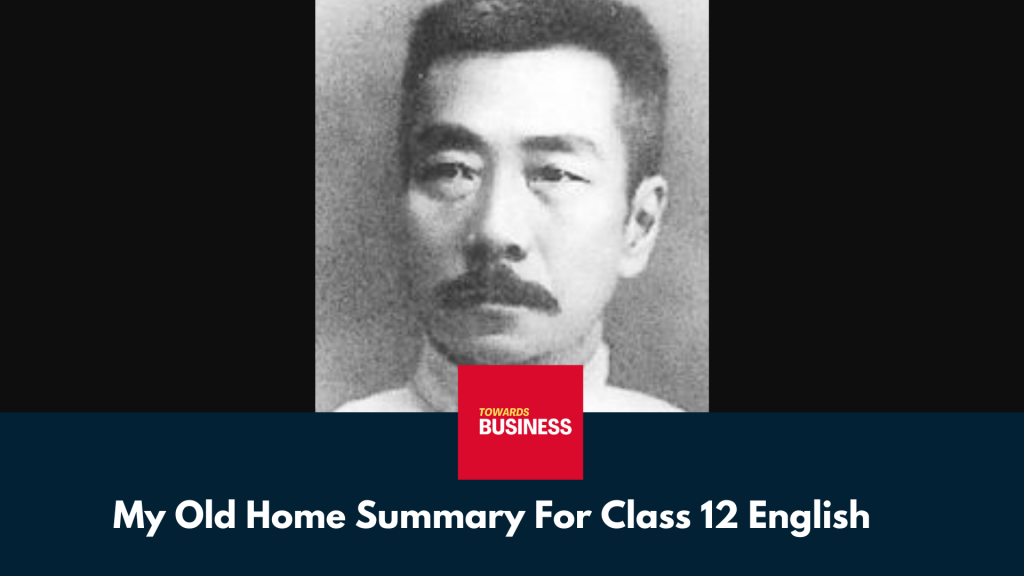“My Old Home” is an autobiographical story written by the Chinese writer Lu Xun. The conflict between Xun’s memories and realities is illustrated in the narrative “My Old Home,” which is about his memories from childhood to middle life. The narrative describes Xun’s feelings after spending several years away from home and arriving at his long-ago home forces his memories to confront the realities of the truths. His realities are in conflict with his prior worldviews and understandings.

In this article, we’ve listed all the question answers as well as the summary of “My Old Home” exercise as part of the class 12 English curriculum. Here is the table of contents:
- My Old Home Exercise: All Question and Answers For Class 12 English
- My Old Home Exercise: Reference to the Context For Class 12 English
- My Old Home Exercise: Reference Beyond The Text For Class 12 English
- My Old Home Summary For Class 12 English
My Old Home Exercise: All Question and Answers For Class 12 English

Listed below are all the questions and answers for “My Old Home” exercise for Class 12 English.
a. How does the narrator describe his feeling at the arrival of his old home?
At the arrival, the narrator perceives the mixed and blended emotions. He feels pleasure and happiness. In his childhood, his hometown was lovely where the green sky lies above. But now, he saw that everything had changed. The green sky changed into a vast and greying sky: they were gloomy, deserted, devoid of any deception of life. There is no sign of development in his hometown. The condition of his home was extremely bad. His childhood deceived him here and made him nostalgic.
b. What were the three kinds of servants in China then? What does it indicate about contemporary Chinese society?
There were three kinds of Chinese servants: dailies, yearlongs and ,busy-mothers. First are day workers, sometimes known as short-timers. Yearlongs are people who work for the same family all year or more. Finally, Busy-mothers were landowners who only worked for one family at a time, such as around New Year’s festivals, or when rent was due to pay.
The kinds of servant in former Chinese society implies that there was a slavery system and a trend of dividing the work on the basis of level.
c. What makes the narrator nostalgic? What did he do with Runtu in the teenage ?
As the narrator’s mother asks him to meet Runtu, he becomes nostalgic. He played with Runtu on the sandy ground among watermelons and stabbing the Zha in the teenager.
d. How did Runtu hunt a Zha in his young age?
Zha was a creature that ate watermelons. Runtu used to stand watch over watermelons on the beach to keep Zha at bay. He attacked Zha with his knife, using all of his strength at his tender age.
e. How does the narrator make a humorous picture of Mrs. Yang?
The narrator creates a humorous picture of Mrs Yang by linking her with a bean curd lady who accuses him of being miserly because he refuses to give her his furniture.
f. According to the narrator, what were different factors that made Runtu a poor man throughout his life?
Before leaving the old residence, the narrator assists Runtu by supplying him with essential household supplies. Since they were leaving the house and Runtu was destitute, the narrator provides him with two huge tables, a few candles, an incense burner, and a set of scales.
g. How does the narrator help Runtu before leaving the old home?
The narrator helps Runtu by providing him with two long tables, an incense burner, some candlesticks, and a set of scales before leaving the old home.
h. How does the author differentiate two kinds of idols?
Superstitious idols and hope are the two idols described in the narrative. He differentiates between these two sorts of idols, claiming that superstitious idols are worshiped in the short term because people want something instantly, whereas hope is a long-term need that humans want in most circumstances.
My Old Home Exercise: Reference to the Context For Class 12 English
Listed below are the answers to the ‘Reference to the context’ part of My Old Home.
a. While reading the friendship between the narrator and Runtu, Hindu readers remember the friendship between Krishna and Sudama. Which particular description reminds you of the mythological example?
While reading about the narrator’s friendship with Runtu, Hindu readers are reminded of Krishna’s friendship with Sudama. The narrative of Krishna and Sudama is based on the ancient Mahabharata. In this narrative (My Old Home), the circumstance of Xun’s companion Runtu is similar to that of Krishna’s friend Sudama. Some of the details in the narrative ‘My Old Home’ remind us of this mythological example.
- Sudama was Lord Krishna’s classmate and close friend. Lord Krishna was a king. Sudama was a poor, impoverished Brahmin. The friendship and relationship of Lu Xun and Runtu are similar in that the former is from the wealthy and upper class as a master and the latter is very poor.
- Sudama felt very shy when he visited Krishna same as Runtu felt ashamed and nervous as he meet his friend and master Lu Xun
- At last, Krishna helped Sudhama by transforming his hut into a palatial mansion with every facility available to live a comfortable life. This instance is not identical to the Mahabharata epic, yet it is comparable. Xun did not transform Runtu’s residence into a mansion, but he did provide him with various household goods that made Runtu’s life a little simpler than in the past.
We learn from both stories that nothing in life comes for free and that a friend in need is a friend indeed.
b. How does the story support the proposition that the relationships of childhood are innocent, impartial, and disinterested?
The friendship between Xun and Runtu in ‘My Old Home’ supports the proposition that childhood connections are pure, unbiased, and disinterested. We all know that children are inherently natural. They are innocent. They have no concept of life or death, love or hatred, struggle or perseverance, hatred or betrayal, or other social limits. They have no idea what is rich and what is poor. Which is the upper and which is the lower class. Children make friends in their childhood for reasons other than friendship.
Childhood friendship is pure and unchangeable. They are kind and eager to help in the future. The bond formed in childhood does not alter. Later, however, different social limits and greed make them separate. When the urge is satisfied, the majority of friendships become stories.
The friendship between Xun and Runtu is depicted in the story. Xun is shown as wealthy, whereas Runtu is portrayed as a poor person. However, their bond is as strong as it was when they were children. They used to have fun and play together. When Runtu is suffering from poverty and requires assistance, Xun provides household goods such as a large table and an incense burner to make his life a bit easier. As a result, Xun’s helpful character and their pure friendship are examples of innocent and unbiased childhood relationships.
c. After reading the story, what inferences can you make about contemporary Chinese economic and social systems?
The story ‘My Old Home’ is based in contemporary China which shows the significance of real friendships while also providing a glimpse into ancient Chinese civilization. In this narrative, the narrator describes the geographical aspects, different sorts of classes, and the importance of friendship. The two major characters, Xun and Runtu, are shown as impoverished and affluent individuals to represent the economic disparity in ancient civilization. Many assumptions regarding the present Chinese economic and social systems may be formed after reading the story.
The story depicts agriculture as the primary occupation of people in ancient Chinese civilization. As a result, the economy and income of persons involved in agricultural activities were poor. They are making things difficult for them. They couldn’t even feed their families. As a result, the story’s main subject is the bad economic state of Chinese society.
In addition, the story addresses the many socioeconomic classes of individuals and servants. The general population was separated into two classes: wealthy or upper class and poor or lower class. Since the impoverished had to earn a livelihood as well, becoming a servant was a custom. They were called year-longs if they worked for a whole year, short-timers if they worked for a day or a short period, and busy-mothers if they owned land or worked for a certain family just during holidays and when rent was collected.
Persons from one class were not allowed to have any relationships with people from other or lower classes. This demonstrates a redundant and narrow-minded civilization with inhumane social barriers and prejudice.
d. What does the story indicate about the geographical features of the narrator’s hometown?
Geographically, the story “My Old Home” is set in 1911, during the downfall of the Qing Dynasty in the narrator’s hometown. When the narrative begins, it is winter, and the sky is clouded up with a chilly wind. The narrator looks out the window to towns and villages on a far horizon against a broad and greying sky. The narrator recalls a significantly more beautiful environment. His homeland was most likely little more than what was ahead of him.
The narrator then recalls his visit to his farm, which was under a blue-black sky, under which was a stretch of sandy ground planted with emerald green watermelons stretching as far as the eye could see, and standing in the midst of all those melons, and then about New Year’s celebrations. He also mentions gathering shells along the ocean, going to the beach immediately before spring tides, and nightly guarding the property with his father, catching birds and stabbing creatures such as badgers and porcupines, etc.
My Old Home Exercise: Reference Beyond The Text For Class 12 English
Listed below are the answers to the ‘Reference beyond the text’ part of the My Old Home Exercise
a. Human beings are on the road from time immemorial, always migrating to new places. Write an essay on The Trend of Migration in Nepal in about 300 words.
➜ The Trend of Migration in Nepal
The term “migration” refers to the cross-border or inter-border movement of people for a variety of reasons. People move for personal gain and to express their political views. Nepalese people are migrating both domestically and internationally.
The majority of Nepalese people migrate from rural to urban regions. Most individuals prefer cities over peaceful, healthy rural areas. The majority of Nepalis choose to reside in cities, whereas rural regions are frequently ignored. Youth from the community leave for better chances and the education of their children. Most localities currently have a lack of skilled and young employees. Almost the majority of the residences in the neighborhood are occupied by elderly people.Numerous towns and cities have lost population as a result of migration. This tendency has caused a lot of relationships to fail.
People are moving to other nations in addition to migrating inside their own country. The vast majority of Nepalese nationals and their families have left their homeland. As a result of this trend, people have been separated from their families, countries, and mankind. Many Nepalese people are forced to leave the nation in search of better chances overseas. As a result of this issue, there is a countrywide labor shortage. The government should offer its people with a diverse choice of work and income options.
In brief, Nepal’s migrant population is rapidly expanding. The Nepalese government must respond in order to appropriately control this migratory trend.
b. Find one of your relatives or friends, who has migrated to a new place leaving his/her old home. Talk to him/her and prepare a report on what he/she felt while leaving the old home.
My friend’s brother and his family have lately moved from their hometown to the city of Kathmandu. They sold their ancestral home, along with all of its belongings, before moving to this city. They even gave their belongings to their relatives for free. They were quite happy to be moving to the city.
After moving to the city, they began living in a rented house for many months. He afterward purchased a large home. I recently met him and chatted about his life in the city. He frequently expressed his regretful thoughts. He claims to be pretty angry here in this city. After spending a year here, he is still filled with nostalgia. He is often reminded of his hometown and relatives. He believes that his decision to leave his hometown was a mistake. He still regrets his hasty decision. His family members are experiencing the same emotions. They are distressed to be separated from their motherland.
They have discovered that city life is very different from what they expected. He still recalls his family’s tearful expressions and sorrowful farewells.
After hearing such a dialogue and his affection for his homeland, the people over there, and the mesmerizing beauty of his hometown have always attracted him so, I believe he might be going back to his hometown after a while.
My Old Home Summary For Class 12 English

Here is the summary for the My Old Home for class 12 English.
This short story “My Old Home” is a story of the conflict between childhood memories and present realities. This story has been written by the Chinese writer Lu Xun. The main narrator of this story is the writer himself who has presented his childhood memories and present realities.
According to the narrator, he returned to his hometown after more than twenty years and a journey of over 600 miles. He had a strong attachment to his hometown. He had a deep affection for his childhood house.. But when he arrived and saw his hometown under the clouds, he became upset at its unprogressive, desolate, and scattered state. His ancient home had been exceedingly lovely in the past, and many members of his clan had lived there. He even claimed that his attitude about his hometown changed when he arrived in an upset mood. He came to his hometown with the express intention of saying “Goodbye” for the last time.
His mother welcomed him back when he came home. He met his nephew Hong’er. He told his mother about a rental house that was close to where he worked. They would move there. He wanted to sell old furniture so that he could buy new furniture for his rental home. His mother informed him about Runtu.
The narrator longed to see his childhood pal Runtu. The narrator saw childhood memories beside Runtu. He noticed Runtu wearing a silver necklace and holding a pitchfork. He observed Runtu thrusting zha with all his strength. Zha, on the other hand, blocked his punch and slid between his legs. He remembered working-class people working full-time, everyday, and part-time. The narrator and Runtu were guarding watermelons against zha in his memories. He remembered what Runtu had told him. Many relatives and others made visits to his childhood home.
Mrs. Yang was a talkative and entertaining lady. Her description was rather entertaining. He referred to her as a geometry box’s compass. Mrs. Yang’s actions surprised the narrator. She surrounded the storyteller. The narrator afterward remembered her. Mrs. Yang, renowned as “A Beancurd Beauty” in his youth, powdered herself in her beancurd business.
The narrator’s decision to sell his former home’s furnishings prompted Mrs. Yang’s words of caution. After several years, the narrator encountered Runtu. It hurt him to say “Master.” It was known to the narrator and his mother that Runtu was poor and had numerous children.
Runtu was pressured by responsibility, high taxes, troops, robbers, government officials, landed gentry, social disparities, and so on. These circumstances kept him poor for the rest of his life. The narrator and his mother decided to help Runtu by giving him old home items. Runtu picked several antiques. He also mocked Runtu with his choices.
After nine days, when the narrator departed he become quite nostalgic. He thought about Runtu and his act of worshipping superstitious idols. He realized the hope that people always desired. He expected his nephew Hong’er and Runtu’s son Shuisheng to have a fine relationship in the future. He realized his present realities against his memories. He left his memories in his past and moved toward his new destination.
The main characters of the “My Old Home” Story have been introduced below:
| Characters | Introduction |
|---|---|
| Lu Shun | The young master who went out to purchase a new house. |
| Jun Tu- | A timid yet “spirited” former Lu Hsun servant. |
| Mrs. Yang | The owner of the bean curd store beside Lu Hsun’s former house, |
| Hung Erh | Lu Xun’s timid nephew |
| Shu Sheng | Jun Tu’s 5th son |
Moral/Theme of the story ” My Old Home”
The narrative of My Old Home depicts the conflict between memories and realities. This narrative depicts how things are not the same. They change continuously. Future generations’ perceptions and understandings may differ from ours. This narrative also shows that spiritual love exists between childhood buddies rather than adult friends.
